brake fluid HYUNDAI IONIQ 6 2023 Owners Manual
[x] Cancel search | Manufacturer: HYUNDAI, Model Year: 2023, Model line: IONIQ 6, Model: HYUNDAI IONIQ 6 2023Pages: 582, PDF Size: 10.77 MB
Page 82 of 582
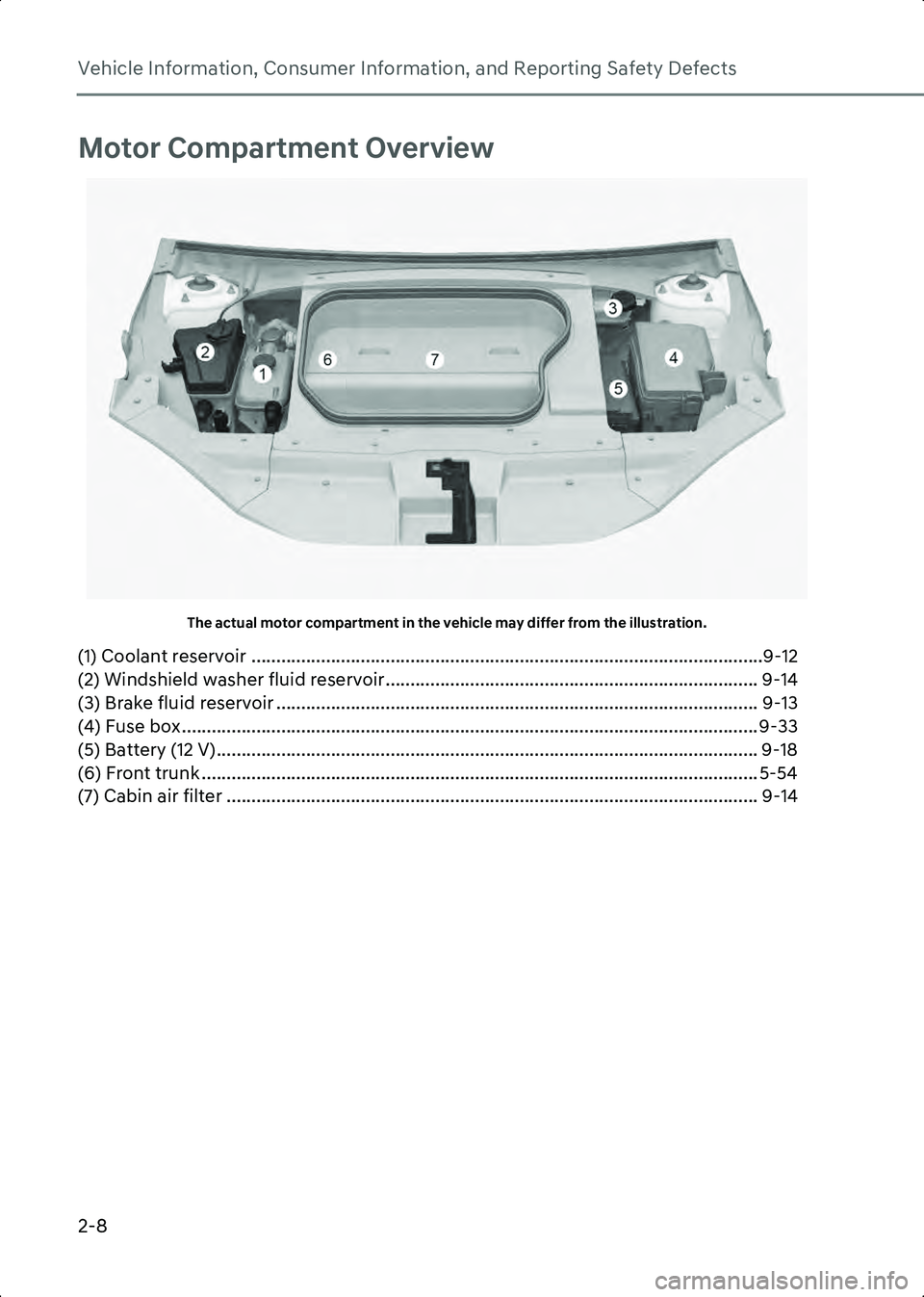
Vehicle Information, Consumer Information, and Reporting Safety Defects
2-8
Motor Compartment Overview
A1000901The actual motor compartment in the vehicle may differ from the illustration.
(1) Coolant reservoir .......................................................................................................9-12
(2) Windshield washer fluid reservoir........................................................................... 9-14
(3) Brake fluid reservoir ................................................................................................. 9-13
(4) Fuse box.................................................................................................................... 9-33
(5) Battery (12 V)............................................................................................................. 9-18
(6) Front trunk ................................................................................................................ 5-54
(7) Cabin air filter ........................................................................................................... 9-14
Hyundai_CE_en_US.book Page 8
Page 88 of 582
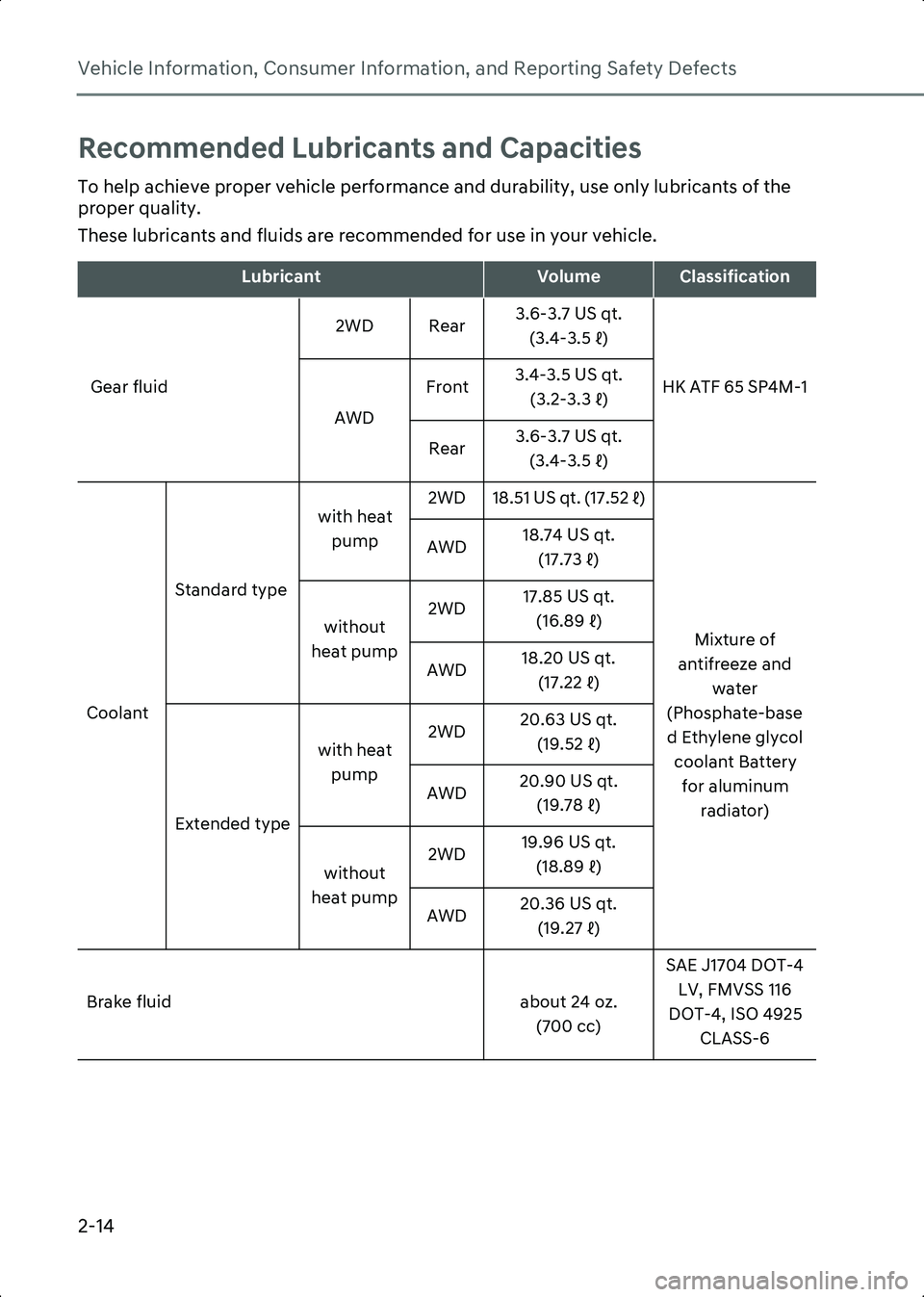
Vehicle Information, Consumer Information, and Reporting Safety Defects
2-14
Recommended Lubricants and Capacities
To help achieve proper vehicle performance and durability, use only lubricants of the
proper quality.
These lubricants and fluids are recommended for use in your vehicle.
LubricantVolumeClassification
Gear fluid 2WD Rear
3.6-3.7 US qt.
(3.4-3.5 ℓ)
HK ATF 65 SP4M-1
AWD Front
3.4-3.5 US qt.
(3.2-3.3 ℓ)
Rear 3.6-3.7 US qt.
(3.4-3.5 ℓ)
Coolant Standard type
with heat
pump 2WD 18.51 US qt. (17.52 ℓ)
Mixture of
antifreeze and water
(Phosphate-base
d Ethylene glycol coolant Battery for aluminum radiator)
AWD
18.74 US qt.
(17.73 ℓ)
without
heat pump 2WD
17.85 US qt.
(16.89 ℓ)
AWD 18.20 US qt.
(17.22 ℓ)
Extended type with heat
pump 2WD
20.63 US qt.
(19.52 ℓ)
AWD 20.90 US qt.
(19.78 ℓ)
without
heat pump 2WD
19.96 US qt.
(18.89 ℓ)
AWD 20.36 US qt.
(19.27 ℓ)
Brake fluid
about 24 oz. (700 cc) SAE J1704 DOT-4
LV, FMVSS 116
DOT-4, ISO 4925 CLASS-6
Hyundai_CE_en_US.book Page 14
Page 158 of 582

Instrument Cluster
4-8
• When there is a malfunction with the SRS.
If the Airbag warning light remains
illuminated while driving, have the
vehicle inspected by an authorized
HYUNDAI dealer.
Regenerative Brake Warning Light
WL_RegenerativeBreakWarningLamp
This warning light illuminates:
When the regenerative brake does not
operate and the brake does not perform
well. This causes the Brake Warning light
(red) and Regenerative Parking Brake
Warning Light (yellow) to illuminate
simultaneously.
In this case, drive safely and have your
vehicle inspected by an authorized
HYUNDAI dealer.
The operation of the brake pedal may be
more difficult than normal and the
braking distance can increase.
Parking Brake and Brake Fluid
Warning Light
WL_BreakWarningLamp
This warning light illuminates:
When the Start/Stop button is in the ON
position. The Parking Brake warning light
illuminates for about 3 seconds and then goes off once the parking brake is
released.
• Whenever the parking brake is applied.
• Whenever the brake fluid level in the
reservoir is low.
- If the warning light illuminates with the parking brake released, it
indicates the brake fluid level in the
reservoir is low.
• When the regenerative brake does not operate.
If the brake fluid level in the reservoir is
low:
1. Drive carefully to the nearest safe location and stop your vehicle.
2. With the motor stopped, check the brake fluid level immediately and add
fluid as required (For more information,
refer to the “Brake Fluid” section in
chapter 9). After adding brake fluid,
check all brake components for fluid
leaks. If a brake fluid leak is found, or if
the warning light remains on, or if the
brakes do not operate properly, do not
drive the vehicle. Have the vehicle
inspected by an authorized HYUNDAI
dealer.
Dual-diagonal braking system
Your vehicle is equipped with the
dual-diagonal braking system. This
means you still have braking on two
wheels even if one of the dual systems
fails.
With only one of the dual systems
working, more than normal pedal travel
and greater pedal force are required to
stop the vehicle.
Also, the vehicle does not stop in a short
distance if only a portion of the braking
system is working.
Hyundai_CE_en_US.book Page 8
Page 159 of 582
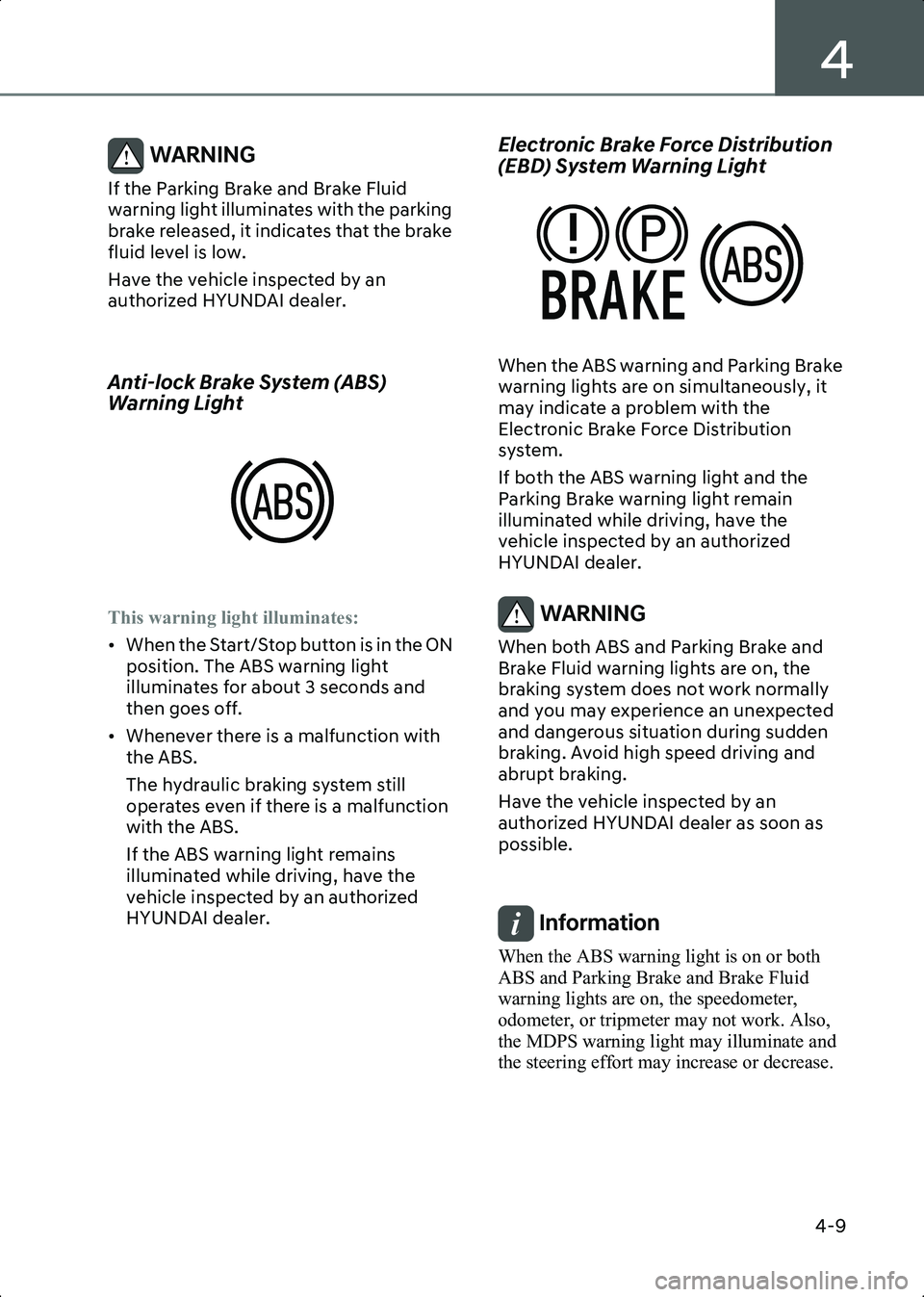
4
4-9
WARNING If the Parking Brake and Brake Fluid
warning light illuminates with the parking
brake released, it indicates that the brake
fluid level is low.
Have the vehicle inspected by an
authorized HYUNDAI dealer.
Anti-lock Brake System (ABS)
Warning Light
WL_ABSWarningLamp
This warning light illuminates:
• When the Start/Stop button is in the ON position. The ABS warning light
illuminates for about 3 seconds and
then goes off.
• Whenever there is a malfunction with the ABS.
The hydraulic braking system still
operates even if there is a malfunction
with the ABS.
If the ABS warning light remains
illuminated while driving, have the
vehicle inspected by an authorized
HYUNDAI dealer.
Electronic Brake Force Distribution
(EBD) System Warning Light
WL_EBDWarningLamp
When the ABS warning and Parking Brake
warning lights are on simultaneously, it
may indicate a problem with the
Electronic Brake Force Distribution
system.
If both the ABS warning light and the
Parking Brake warning light remain
illuminated while driving, have the
vehicle inspected by an authorized
HYUNDAI dealer.
WARNING When both ABS and Parking Brake and
Brake Fluid warning lights are on, the
braking system does not work normally
and you may experience an unexpected
and dangerous situation during sudden
braking. Avoid high speed driving and
abrupt braking.
Have the vehicle inspected by an
authorized HYUNDAI dealer as soon as
possible.
Information When the ABS warning light is on or both
ABS and Parking Brake and Brake Fluid
warning lights are on, the speedometer,
odometer, or tripmeter may not work. Also,
the MDPS warning light may illuminate and
the steering effort may increase or decrease.
Hyundai_CE_en_US.book Page 9
Page 339 of 582
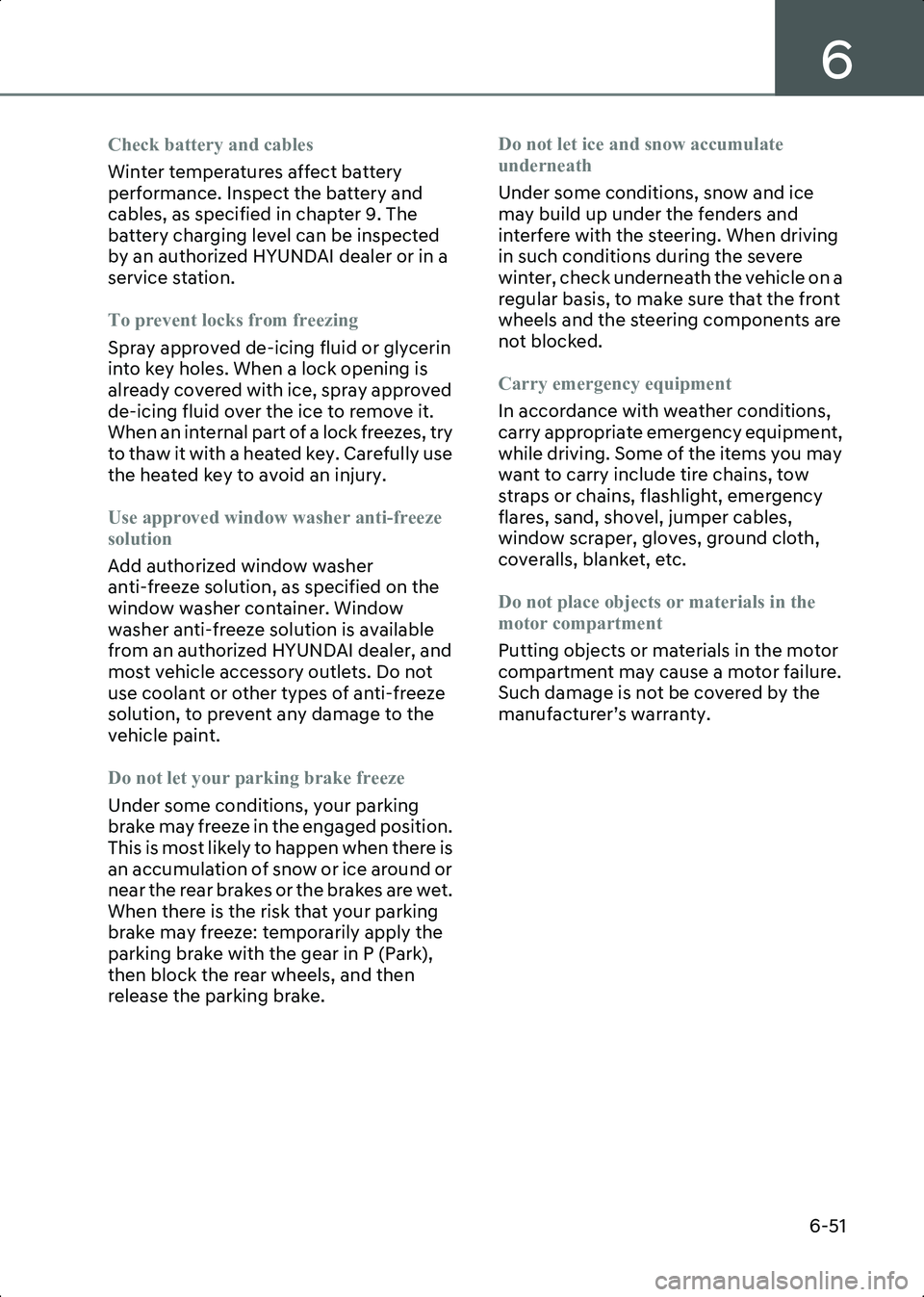
6
6-51
Check battery and cables
Winter temperatures affect battery
performance. Inspect the battery and
cables, as specified in chapter 9. The
battery charging level can be inspected
by an authorized HYUNDAI dealer or in a
service station.
To prevent locks from freezing
Spray approved de-icing fluid or glycerin
into key holes. When a lock opening is
already covered with ice, spray approved
de-icing fluid over the ice to remove it.
When an internal part of a lock freezes, try
to thaw it with a heated key. Carefully use
the heated key to avoid an injury.
Use approved window washer anti-freeze
solution
Add authorized window washer
anti-freeze solution, as specified on the
window washer container. Window
washer anti-freeze solution is available
from an authorized HYUNDAI dealer, and
most vehicle accessory outlets. Do not
use coolant or other types of anti-freeze
solution, to prevent any damage to the
vehicle paint.
Do not let your parking brake freeze
Under some conditions, your parking
brake may freeze in the engaged position.
This is most likely to happen when there is
an accumulation of snow or ice around or
near the rear brakes or the brakes are wet.
When there is the risk that your parking
brake may freeze: temporarily apply the
parking brake with the gear in P (Park),
then block the rear wheels, and then
release the parking brake.Do not let ice and snow accumulate
underneath
Under some conditions, snow and ice
may build up under the fenders and
interfere with the steering. When driving
in such conditions during the severe
winter, check underneath the vehicle on a
regular basis, to make sure that the front
wheels and the steering components are
not blocked.
Carry emergency equipment
In accordance with weather conditions,
carry appropriate emergency equipment,
while driving. Some of the items you may
want to carry include tire chains, tow
straps or chains, flashlight, emergency
flares, sand, shovel, jumper cables,
window scraper, gloves, ground cloth,
coveralls, blanket, etc.
Do not place objects or materials in the
motor compartment
Putting objects or materials in the motor
compartment may cause a motor failure.
Such damage is not be covered by the
manufacturer’s warranty.
Hyundai_CE_en_US.book Page 51
Page 517 of 582

9
9. Maintenance
Motor Compartment ....................................................................................................... 9-4
Maintenance Services ..................................................................................................... 9-5Owner’s Responsibility ................................................................................................ 9-5
Owner Maintenance Precautions ............................................................................... 9-5
Owner Maintenance ........................................................................................................9-6 Owner Maintenance Schedule....................................................................................9-6
Scheduled Maintenance Services .................................................................................. 9-7 Normal Maintenance Schedule ..................................................................................9-8
Normal Maintenance Schedule ..................................................................................9-9
Maintenance Under Severe Usage and Low Mileage Conditions .......................... 9-10
Explanation of Scheduled Maintenance Items............................................................. 9-11 Cooling System ........................................................................................................... 9-11
Coolant ........................................................................................................................ 9-11
Gear Fluid .................................................................................................................... 9-11
Brake Hoses and Lines................................................................................................ 9-11
Brake Fluid ................................................................................................................... 9-11
Brake Discs, Pads, Calipers and Rotors ..................................................................... 9-11
Suspension Mounting Bolts ....................................................................................... 9-11
Steering Gear Box, Linkage & Boots/Lower Arm Ball Joint ..................................... 9-11
Drive Shafts and Boots ............................................................................................... 9-11
Air Conditioning Refrigerant ...................................................................................... 9-11
Coolant ............................................................................................................................9-12 Changing Coolant ...................................................................................................... 9-13
Brake Fluid ..................................................................................................................... 9-13 Checking the Brake Fluid Level................................................................................. 9-13
Gear Fluid ....................................................................................................................... 9-13
Washer Fluid .................................................................................................................. 9-14 Checking the Washer Fluid Level ............................................................................. 9-14
Cabin Air Filter ............................................................................................................... 9-14 Filter Inspection ......................................................................................................... 9-14
Filter Replacement..................................................................................................... 9-14
Wiper Blades .................................................................................................................. 9-15 Blade Inspection ........................................................................................................ 9-15
Blade Replacement.................................................................................................... 9-15
Battery (12 V) ...................................................................................................................9-17
Hyundai_CE_en_US.book Page 1
Page 520 of 582
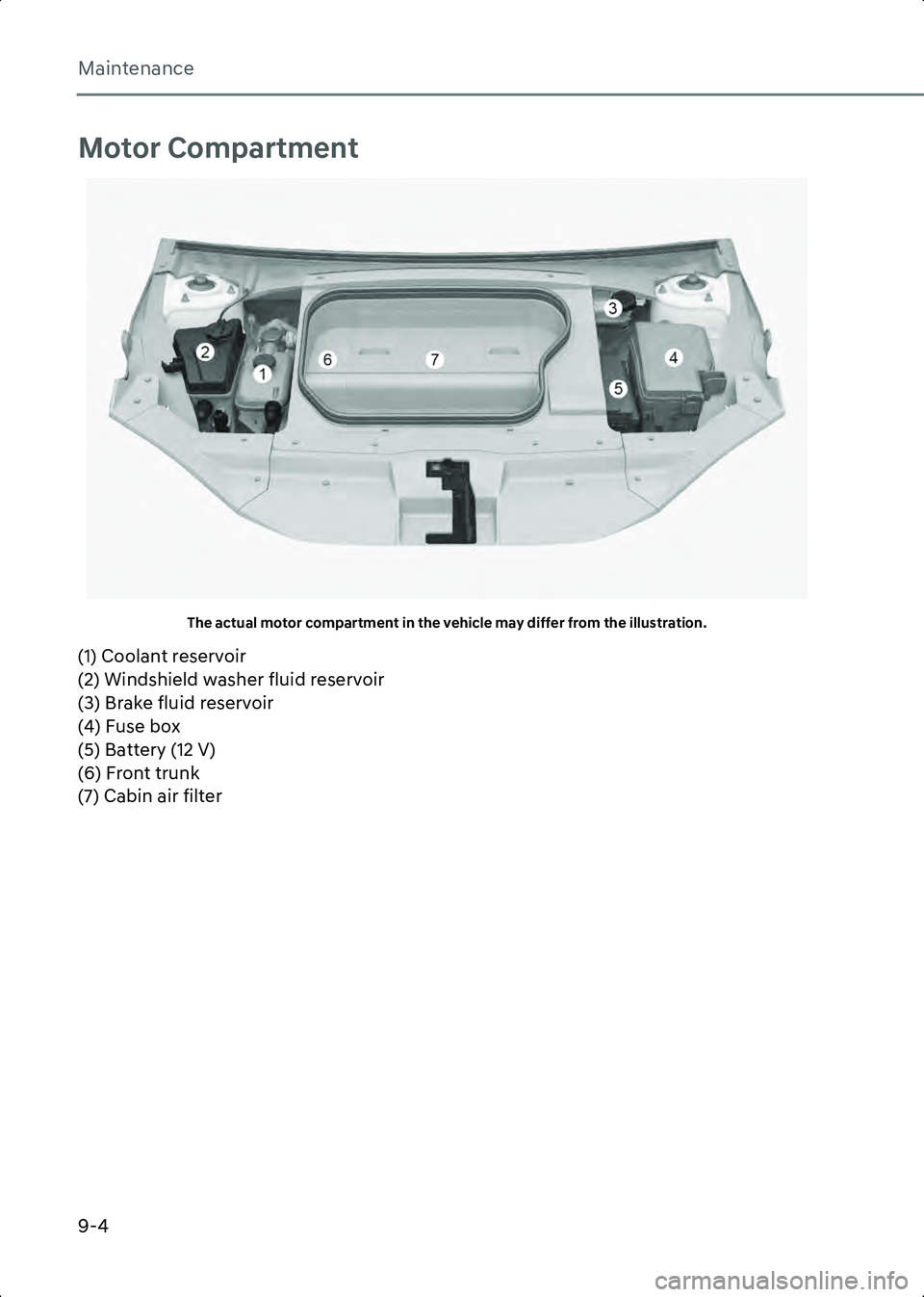
Maintenance
9-4
Motor Compartment
A1000901The actual motor compartment in the vehicle may differ from the illustration.
(1) Coolant reservoir
(2) Windshield washer fluid reservoir
(3) Brake fluid reservoir
(4) Fuse box
(5) Battery (12 V)
(6) Front trunk
(7) Cabin air filter
Hyundai_CE_en_US.book Page 4
Page 522 of 582
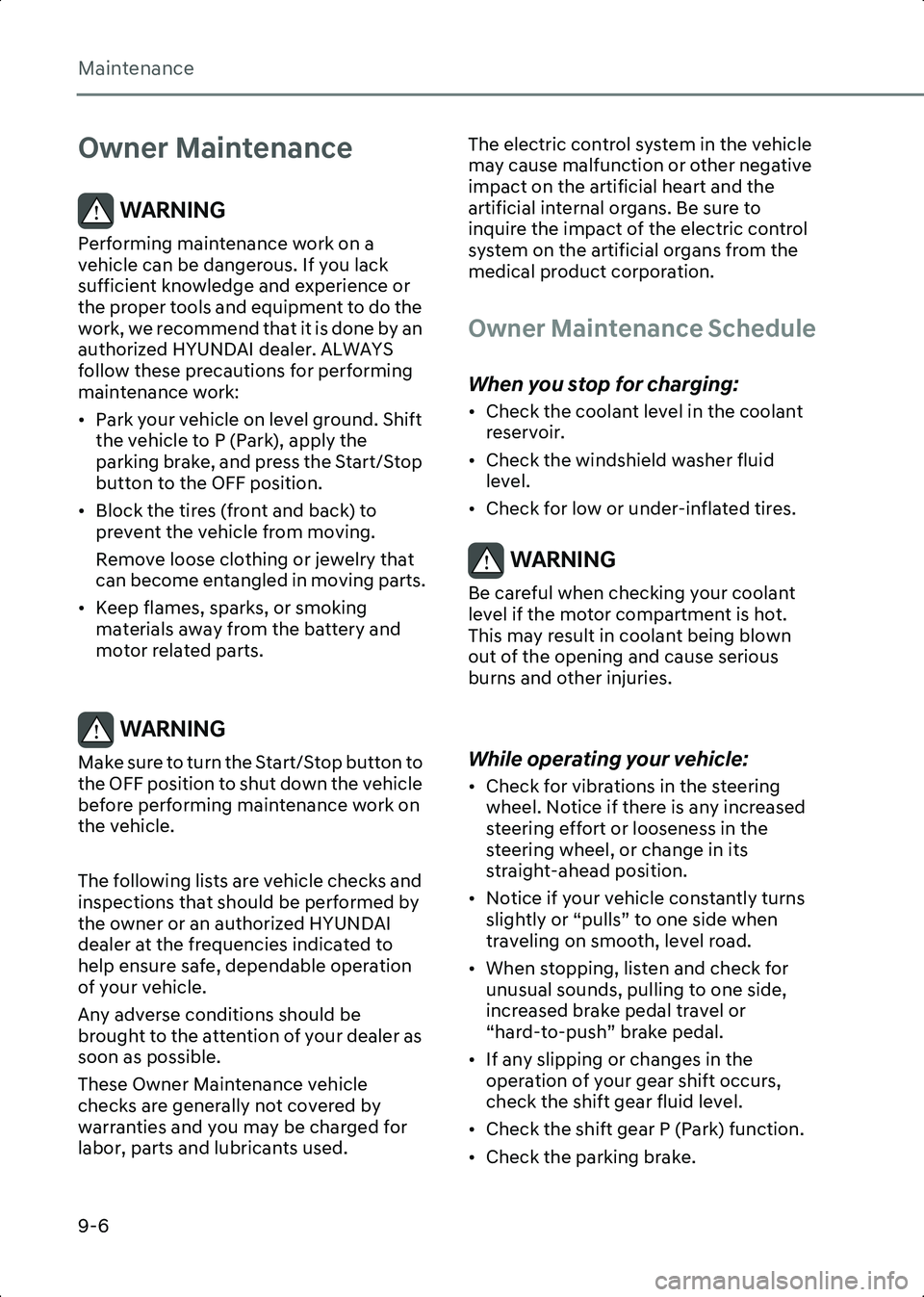
Maintenance
9-6
Owner Maintenance
WARNING Performing maintenance work on a
vehicle can be dangerous. If you lack
sufficient knowledge and experience or
the proper tools and equipment to do the
work, we recommend that it is done by an
authorized HYUNDAI dealer. ALWAYS
follow these precautions for performing
maintenance work:
• Park your vehicle on level ground. Shift the vehicle to P (Park), apply the
parking brake, and press the Start/Stop
button to the OFF position.
• Block the tires (front and back) to prevent the vehicle from moving.
Remove loose clothing or jewelry that
can become entangled in moving parts.
• Keep flames, sparks, or smoking materials away from the battery and
motor related parts.
WARNING Make sure to turn the Start/Stop button to
the OFF position to shut down the vehicle
before performing maintenance work on
the vehicle.
The following lists are vehicle checks and
inspections that should be performed by
the owner or an authorized HYUNDAI
dealer at the frequencies indicated to
help ensure safe, dependable operation
of your vehicle.
Any adverse conditions should be
brought to the attention of your dealer as
soon as possible.
These Owner Maintenance vehicle
checks are generally not covered by
warranties and you may be charged for
labor, parts and lubricants used. The electric control system in the vehicle
may cause malfunction or other negative
impact on the artificial heart and the
artificial internal organs. Be sure to
inquire the impact of the electric control
system on the artificial organs from the
medical product corporation.
Owner Maintenance Schedule
When you stop for charging:
• Check the coolant level in the coolant
reservoir.
• Check the windshield washer fluid level.
• Check for low or under-inflated tires.
WARNING Be careful when checking your coolant
level if the motor compartment is hot.
This may result in coolant being blown
out of the opening and cause serious
burns and other injuries.
While operating your vehicle:
• Check for vibrations in the steering wheel. Notice if there is any increased
steering effort or looseness in the
steering wheel, or change in its
straight-ahead position.
• Notice if your vehicle constantly turns slightly or “pulls” to one side when
traveling on smooth, level road.
• When stopping, listen and check for unusual sounds, pulling to one side,
increased brake pedal travel or
“hard-to-push” brake pedal.
• If any slipping or changes in the operation of your gear shift occurs,
check the shift gear fluid level.
• Check the shift gear P (Park) function.
• Check the parking brake.
Hyundai_CE_en_US.book Page 6
Page 523 of 582
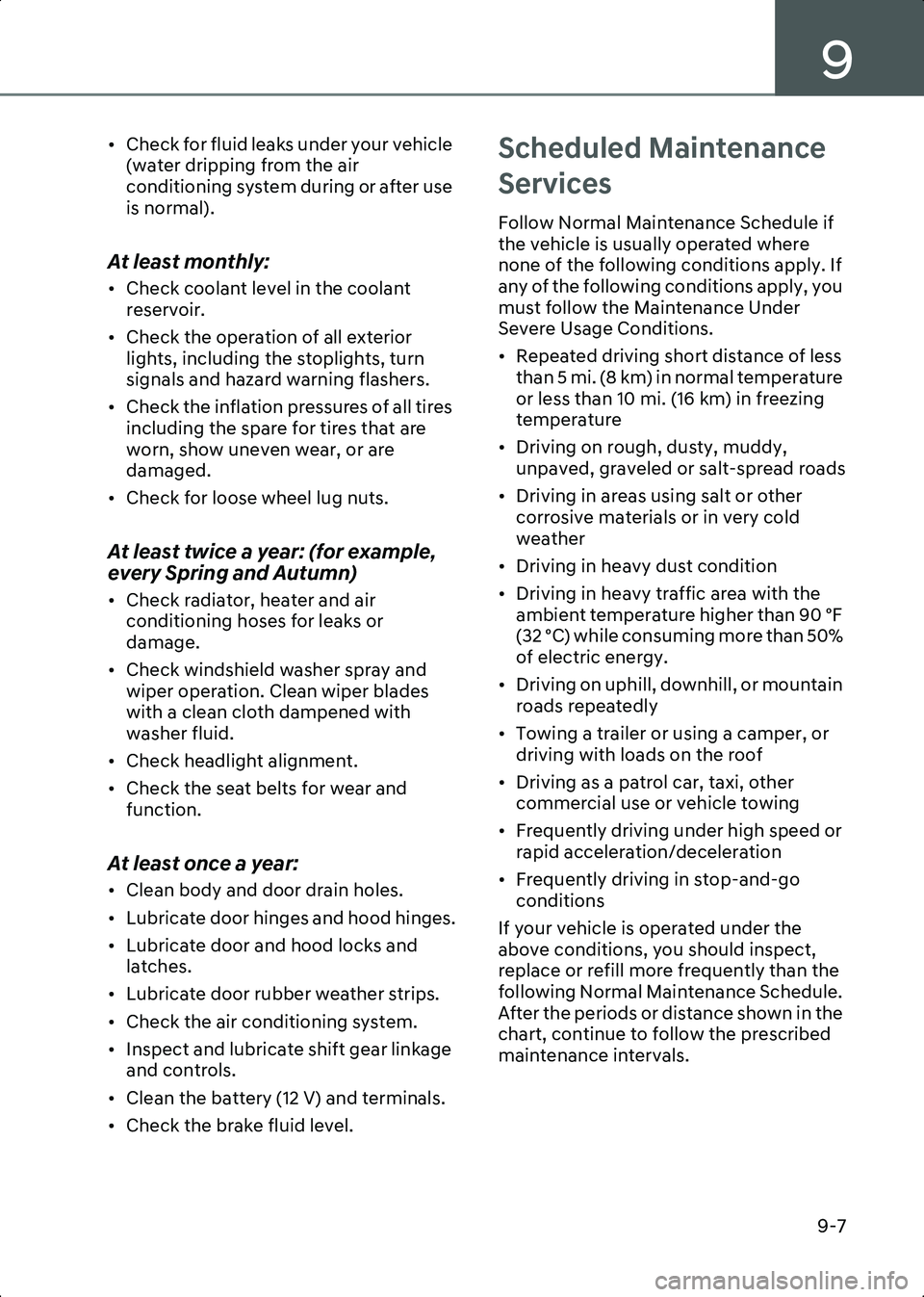
9
9-7
• Check for fluid leaks under your vehicle (water dripping from the air
conditioning system during or after use
is normal).
At least monthly:
• Check coolant level in the coolant reservoir.
• Check the operation of all exterior lights, including the stoplights, turn
signals and hazard warning flashers.
• Check the inflation pressures of all tires including the spare for tires that are
worn, show uneven wear, or are
damaged.
• Check for loose wheel lug nuts.
At least twice a year: (for example,
every Spring and Autumn)
• Check radiator, heater and air conditioning hoses for leaks or
damage.
• Check windshield washer spray and wiper operation. Clean wiper blades
with a clean cloth dampened with
washer fluid.
• Check headlight alignment.
• Check the seat belts for wear and function.
At least once a year:
• Clean body and door drain holes.
• Lubricate door hinges and hood hinges.
• Lubricate door and hood locks and latches.
• Lubricate door rubber weather strips.
• Check the air conditioning system.
• Inspect and lubricate shift gear linkage and controls.
• Clean the battery (12 V) and terminals.
• Check the brake fluid level.
Scheduled Maintenance
Services
Follow Normal Maintenance Schedule if
the vehicle is usually operated where
none of the following conditions apply. If
any of the following conditions apply, you
must follow the Maintenance Under
Severe Usage Conditions.
• Repeated driving short distance of less than 5 mi. (8 km) in normal temperature
or less than 10 mi. (16 km) in freezing
temperature
• Driving on rough, dusty, muddy, unpaved, graveled or salt-spread roads
• Driving in areas using salt or other corrosive materials or in very cold
weather
• Driving in heavy dust condition
• Driving in heavy traffic area with the ambient temperature higher than 90 ºF
(32 ºC) while consuming more than 50%
of electric energy.
• Driving on uphill, downhill, or mountain roads repeatedly
• Towing a trailer or using a camper, or driving with loads on the roof
• Driving as a patrol car, taxi, other commercial use or vehicle towing
• Frequently driving under high speed or rapid acceleration/deceleration
• Frequently driving in stop-and-go conditions
If your vehicle is operated under the
above conditions, you should inspect,
replace or refill more frequently than the
following Normal Maintenance Schedule.
After the periods or distance shown in the
chart, continue to follow the prescribed
maintenance intervals.
Hyundai_CE_en_US.book Page 7
Page 525 of 582

9
9-9
Normal Maintenance Schedule
*1 Consult an authorized HYUNDAI dealer, when replacing or adding coolant.
I: Inspect and if necessary, adjust, correct, clean or replace.
R: Replace or change.
MAINTENANCE
INTERVALSMAINTE NANCEITEM1224364860728496108120132144156
81624324048566472808896104
13263952657891104117130143156169
Drive shafts and
boots I I I I I I
Replace Climate
Control Air Filter
(For Evaporator and
Blower Unit) I R I R I R I R I R I R I
Gear fluid III
Rotate Tires
(Includes Tire
Pressure and Tread
Wear Inspection) Rotate every 8,000 mi. (13,000 km) or 12 months
Coolant
*1At first, replace 120,000 mi. (200,000 km) or 120 months.
After that, replace every 24,000 mi. (40,000 km) or 24 month.
Brake fluid Inspect every 7,500 mi. (12,000 km) or 12 months,
Replace every 60,000 mi. (96,000 km) or 48 months
Hyundai_CE_en_US.book Page 9